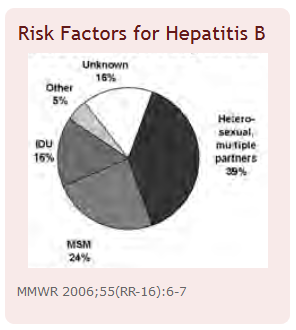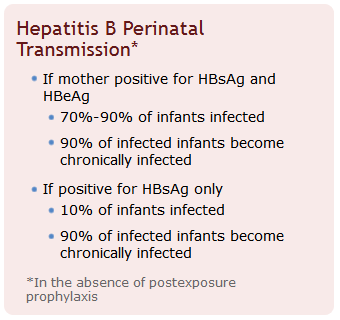Hepatitis B risk factors: Difference between revisions
m (Bot: Removing from Primary care) |
|||
| (34 intermediate revisions by 9 users not shown) | |||
| Line 1: | Line 1: | ||
__NOTOC__ | __NOTOC__ | ||
{{Hepatitis B}} | {{Hepatitis B}} | ||
{{CMG}} | {{CMG}}; {{AE}} {{JS}}, {{SaraM}} | ||
==Overview== | |||
Common risk factors in the development of HBV infection include sexual contact with infected individuals, sharing a household with a carrier, [[intravenous drug use]], travel to [[endemic]] regions, [[perinatal]] transmission from infected mothers to infants, and certain occupations. | |||
==Risk Factors== | ==Risk Factors== | ||
Individuals are at increased risk of | Individuals who are at increased risk of [[hepatitis B infection]] include:<ref name="WHO-Hepatitis-B_2003">World Health Organization. Department of Cummunicable Disease Surveillance and Response http://apps.who.int/iris/bitstream/10665/67746/1/WHO_CDS_CSR_LYO_2002.2_HEPATITIS_B.pdf</ref><ref name="USPTF-Hepatitis-B">US. Preventive Services Task Force. Screening for Hepatitis B infection. (2014) https://www.uspreventiveservicestaskforce.org/Page/Document/UpdateSummaryFinal/hepatitis-b-virus-infection-screening-2014?ds=1&s=hepatitis%20b Accessed on October 4th, 2016</ref> | ||
* | * Infants born to [[infected]] mothers | ||
* | * Young children in day-care or residential settings with other children in [[endemic]] areas | ||
* | * Sexual/household contacts of [[infected]] persons | ||
* | *Patients and employees in [[hemodialysis]] centers | ||
* | * Injection drug users sharing unsterilized needles | ||
* | * People sharing unsterilized medical or dental equipment | ||
* | * People providing or receiving acupuncture and/or tattooing with unsterilized medical devices | ||
* | * Persons living in regions or travelling to regions with [[endemic]] hepatitis B | ||
*Travel to areas where hepatitis B is common | **Country of origin is the major risk factor for HBV infection (prevalence threshold of 2% or greater to define countries with high risk for HBV infection) | ||
* Sexually active heterosexuals | |||
* Lack of [[vaccination]] in infancy | |||
* Men who have sex with men | |||
* [[Hemophilia]] patients | |||
* Travel to areas where hepatitis B is common | |||
Frequent and routine exposure to [[blood]] or [[serum]] is the common denominator of healthcare occupational exposure.<ref name="WHO">{{cite web | title = Hepatitis B | url = http://www.who.int/csr/disease/hepatitis/HepatitisB_whocdscsrlyo2002_2.pdf }}</ref> | |||
{| | |||
|[[image:Hbvrisk.png|700px|thumb|center|Source: https://www.cdc.gov/]] | |||
|[[image:Hbvperinatal.png|700px|thumb|center|Source: https://www.cdc.gov/]] | |||
|} | |||
===Hepatitis B Reactivation=== | |||
Hepatitis B virus presents in all patients with infection. Patients who are either HBsAg-positive or anti HBc-positive are at the risk of hepatitis B reactivation. | |||
Patients are at risk for HBV reactivation in the following conditions:<ref name="pmid23111095">{{cite journal| author=Lee YH, Bae SC, Song GG| title=Hepatitis B virus (HBV) reactivation in rheumatic patients with hepatitis core antigen (HBV occult carriers) undergoing anti-tumor necrosis factor therapy. | journal=Clin Exp Rheumatol | year= 2013 | volume= 31 | issue= 1 | pages= 118-21 | pmid=23111095 | doi= | pmc= | url=https://www.ncbi.nlm.nih.gov/entrez/eutils/elink.fcgi?dbfrom=pubmed&tool=sumsearch.org/cite&retmode=ref&cmd=prlinks&id=23111095 }} </ref><ref name="pmid22392695">{{cite journal| author=Kim PS, Ho GY, Prete PE, Furst DE| title=Safety and efficacy of abatacept in eight rheumatoid arthritis patients with chronic hepatitis B. | journal=Arthritis Care Res (Hoboken) | year= 2012 | volume= 64 | issue= 8 | pages= 1265-8 | pmid=22392695 | doi=10.1002/acr.21654 | pmc= | url=https://www.ncbi.nlm.nih.gov/entrez/eutils/elink.fcgi?dbfrom=pubmed&tool=sumsearch.org/cite&retmode=ref&cmd=prlinks&id=22392695 }} </ref><ref name="pmid6105519">{{cite journal| author=Sagnelli E, Manzillo G, Maio G, Pasquale G, Felaco FM, Filippini P et al.| title=Serum levels of hepatitis B surface and core antigens during immunosuppressive treatment of HBsAg-positive chronic active hepatitis. | journal=Lancet | year= 1980 | volume= 2 | issue= 8191 | pages= 395-7 | pmid=6105519 | doi= | pmc= | url=https://www.ncbi.nlm.nih.gov/entrez/eutils/elink.fcgi?dbfrom=pubmed&tool=sumsearch.org/cite&retmode=ref&cmd=prlinks&id=6105519 }} </ref><ref name="pmid3884951">{{cite journal| author=Nair PV, Tong MJ, Stevenson D, Roskamp D, Boone C| title=Effects of short-term, high-dose prednisone treatment of patients with HBsAg-positive chronic active hepatitis. | journal=Liver | year= 1985 | volume= 5 | issue= 1 | pages= 8-12 | pmid=3884951 | doi= | pmc= | url=https://www.ncbi.nlm.nih.gov/entrez/eutils/elink.fcgi?dbfrom=pubmed&tool=sumsearch.org/cite&retmode=ref&cmd=prlinks&id=3884951 }} </ref><ref>Europian Medicines Agency. reviews direct-acting antivirals for hepatitis C. (2016) http://www.ema.europa.eu/docs/en_GB/document_library/Referrals_document/Direct-acting_antivirals_for_hepatitis_C_20/Procedure_started/WC500203479.pdf </ref><ref name="FDA">U.S Food and Drug Adminestration. Drug Safety Communication: FDA warns about the risk of hepatitis B reactivating in some patients treated with direct-acting antivirals for hepatitis C http://www.fda.gov/downloads/Drugs/DrugSafety/UCM523499.pdf</ref> | |||
*Receive immunosuppressive therapy | |||
**[[Chemotherapy agents]] | |||
**[[Tumor necrosis factor inhibitor|Tumor necrosis factor (TNF) inhibitor]] ([[Infliximab]]) | |||
**[[Methotrexate]] (particularly following its withdrawal) | |||
**[[Abatacept]] | |||
**[[Ustekinumab]] | |||
**Anti-CD 20 agents ([[Rituximab]] and [[Ofatumumab]]) | |||
**High to moderate dose [[glucocorticoids]] | |||
*Patients treated with direct-acting antivirals for hepatitis C | |||
**Daklinza | |||
**Epclusa | |||
**Exviera | |||
**Harvoni | |||
**Olysio | |||
**Sovaldi | |||
**Viekira Pak/ Viekira Pak XR | |||
**Technivie | |||
**Zepatier | |||
== References == | == References == | ||
{{Reflist|2}} | {{Reflist|2}} | ||
{{WH}} | {{WH}} | ||
{{WS}} | {{WS}} | ||
[[Category:Gastroenterology]] | |||
[[Category:FinalQCRequired]] | |||
[[Category:Emergency mdicine]] | |||
[[Category:Disease]] | |||
[[Category:Up-To-Date]] | |||
[[Category:Infectious disease]] | |||
[[Category:Hepatology]] | |||
Latest revision as of 22:05, 29 July 2020
|
Hepatitis B |
|
Diagnosis |
|
Treatment |
|
Case Studies |
|
Hepatitis B risk factors On the Web |
|
American Roentgen Ray Society Images of Hepatitis B risk factors |
|
Risk calculators and risk factors for Hepatitis B risk factors |
Editor-In-Chief: C. Michael Gibson, M.S., M.D. [1]; Associate Editor(s)-in-Chief: João André Alves Silva, M.D. [2], Sara Mehrsefat, M.D. [3]
Overview
Common risk factors in the development of HBV infection include sexual contact with infected individuals, sharing a household with a carrier, intravenous drug use, travel to endemic regions, perinatal transmission from infected mothers to infants, and certain occupations.
Risk Factors
Individuals who are at increased risk of hepatitis B infection include:[1][2]
- Infants born to infected mothers
- Young children in day-care or residential settings with other children in endemic areas
- Sexual/household contacts of infected persons
- Patients and employees in hemodialysis centers
- Injection drug users sharing unsterilized needles
- People sharing unsterilized medical or dental equipment
- People providing or receiving acupuncture and/or tattooing with unsterilized medical devices
- Persons living in regions or travelling to regions with endemic hepatitis B
- Country of origin is the major risk factor for HBV infection (prevalence threshold of 2% or greater to define countries with high risk for HBV infection)
- Sexually active heterosexuals
- Lack of vaccination in infancy
- Men who have sex with men
- Hemophilia patients
- Travel to areas where hepatitis B is common
Frequent and routine exposure to blood or serum is the common denominator of healthcare occupational exposure.[3]
 |
 |
Hepatitis B Reactivation
Hepatitis B virus presents in all patients with infection. Patients who are either HBsAg-positive or anti HBc-positive are at the risk of hepatitis B reactivation.
Patients are at risk for HBV reactivation in the following conditions:[4][5][6][7][8][9]
- Receive immunosuppressive therapy
- Chemotherapy agents
- Tumor necrosis factor (TNF) inhibitor (Infliximab)
- Methotrexate (particularly following its withdrawal)
- Abatacept
- Ustekinumab
- Anti-CD 20 agents (Rituximab and Ofatumumab)
- High to moderate dose glucocorticoids
- Patients treated with direct-acting antivirals for hepatitis C
- Daklinza
- Epclusa
- Exviera
- Harvoni
- Olysio
- Sovaldi
- Viekira Pak/ Viekira Pak XR
- Technivie
- Zepatier
References
- ↑ World Health Organization. Department of Cummunicable Disease Surveillance and Response http://apps.who.int/iris/bitstream/10665/67746/1/WHO_CDS_CSR_LYO_2002.2_HEPATITIS_B.pdf
- ↑ US. Preventive Services Task Force. Screening for Hepatitis B infection. (2014) https://www.uspreventiveservicestaskforce.org/Page/Document/UpdateSummaryFinal/hepatitis-b-virus-infection-screening-2014?ds=1&s=hepatitis%20b Accessed on October 4th, 2016
- ↑ "Hepatitis B" (PDF).
- ↑ Lee YH, Bae SC, Song GG (2013). "Hepatitis B virus (HBV) reactivation in rheumatic patients with hepatitis core antigen (HBV occult carriers) undergoing anti-tumor necrosis factor therapy". Clin Exp Rheumatol. 31 (1): 118–21. PMID 23111095.
- ↑ Kim PS, Ho GY, Prete PE, Furst DE (2012). "Safety and efficacy of abatacept in eight rheumatoid arthritis patients with chronic hepatitis B." Arthritis Care Res (Hoboken). 64 (8): 1265–8. doi:10.1002/acr.21654. PMID 22392695.
- ↑ Sagnelli E, Manzillo G, Maio G, Pasquale G, Felaco FM, Filippini P; et al. (1980). "Serum levels of hepatitis B surface and core antigens during immunosuppressive treatment of HBsAg-positive chronic active hepatitis". Lancet. 2 (8191): 395–7. PMID 6105519.
- ↑ Nair PV, Tong MJ, Stevenson D, Roskamp D, Boone C (1985). "Effects of short-term, high-dose prednisone treatment of patients with HBsAg-positive chronic active hepatitis". Liver. 5 (1): 8–12. PMID 3884951.
- ↑ Europian Medicines Agency. reviews direct-acting antivirals for hepatitis C. (2016) http://www.ema.europa.eu/docs/en_GB/document_library/Referrals_document/Direct-acting_antivirals_for_hepatitis_C_20/Procedure_started/WC500203479.pdf
- ↑ U.S Food and Drug Adminestration. Drug Safety Communication: FDA warns about the risk of hepatitis B reactivating in some patients treated with direct-acting antivirals for hepatitis C http://www.fda.gov/downloads/Drugs/DrugSafety/UCM523499.pdf